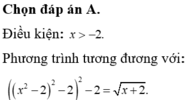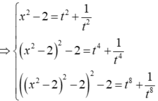Phương trình log 2 x 2 - 2 - 2 2 - 2 = log 4 x + 2 có tất cả bao nhiêu nghiệm thực phân biệt
A.8
B. 12
C. 16
D. 10
Hãy nhập câu hỏi của bạn vào đây, nếu là tài khoản VIP, bạn sẽ được ưu tiên trả lời.





![]()
![]()





Đáp án D
Điều kiện 40 < x < 60
Vậy x cần tìm theo yêu cầu đề là các số nguyên dương chạy từ 41 đến 59; trừ giá trị 50. Có tất cả 18 giá trị thỏa mãn.

a, ĐK: \(4x+4>0\Rightarrow x>-1\)
\(log_6\left(4x+4\right)=2\\ \Leftrightarrow4x+4=36\\ \Leftrightarrow4x=32\\ \Leftrightarrow x=8\left(tm\right)\)
Vậy x = 8.
b, ĐK: \(x-2>0\Rightarrow x>2\)
\(log_3x-log_3\left(x-2\right)=1\\ \Leftrightarrow log_3\left(x^2-2x\right)=1\\ \Leftrightarrow x^2-2x-3=0\\ \Leftrightarrow\left(x-3\right)\left(x+1\right)=0\\ \Leftrightarrow\left[{}\begin{matrix}x=3\left(tm\right)\\x=-1\left(ktm\right)\end{matrix}\right.\)
Vậy x = 3.

\(a,\left(\dfrac{1}{4}\right)^{x-2}=\sqrt{8}\\ \Leftrightarrow\left(\dfrac{1}{2}\right)^{2x-4}=\left(\dfrac{1}{2}\right)^{-\dfrac{3}{2}}\\ \Leftrightarrow2x-4=-\dfrac{3}{2}\\ \Leftrightarrow2x=\dfrac{5}{2}\\ \Leftrightarrow x=\dfrac{5}{4}\)
\(b,9^{2x-1}=81\cdot27^x\\ \Leftrightarrow3^{4x-2}=3^{4+3x}\\ \Leftrightarrow4x-2=4+3x\\ \Leftrightarrow x=6\)
c, ĐK: \(x-2>0\Rightarrow x>2\)
\(2log_5\left(x-2\right)=log_59\\
\Leftrightarrow log_5\left(x-2\right)^2=log_59\\
\Leftrightarrow\left(x-2\right)^2=3^2\\
\Leftrightarrow\left[{}\begin{matrix}x-2=3\\x-2=-3\end{matrix}\right.\\
\Leftrightarrow\left[{}\begin{matrix}x=5\left(tm\right)\\x=-1\left(ktm\right)\end{matrix}\right.\)
Vậy phương trình có nghiệm là x = 5.
d, ĐK: \(x-1>0\Leftrightarrow x>1\)
\(log_2\left(3x+1\right)=2-log_2\left(x-1\right)\\ \Leftrightarrow log_2\left(3x+1\right)\left(x-1\right)=2\\ \Leftrightarrow3x^2-2x-1=4\\ \Leftrightarrow3x^2-2x-5=0\\ \Leftrightarrow\left(3x-5\right)\left(x+1\right)=0\\ \Leftrightarrow\left[{}\begin{matrix}x=\dfrac{5}{3}\left(tm\right)\\x=-1\left(ktm\right)\end{matrix}\right.\)
Vậy phương trình có nghiệm \(x=\dfrac{5}{3}\)

a) \({\log _{\frac{1}{2}}}\left( {x - 2} \right) = - 2\)
Điều kiện: \(x - 2 > 0 \Leftrightarrow x > 2\)
Vậy phương trình có nghiệm là \(x = 6\).
b) \({\log _2}\left( {x + 6} \right) = {\log _2}\left( {x + 1} \right) + 1\)
Điều kiện: \(\left\{ \begin{array}{l}x + 6 > 0\\x + 1 > 0\end{array} \right. \Leftrightarrow \left\{ \begin{array}{l}x > - 6\\x > - 1\end{array} \right. \Leftrightarrow x > - 1\)
Vậy phương trình có nghiệm là \(x = 4\).

a, ĐK: \(x+1>0\Leftrightarrow x>-1\)
\(log\left(x+1\right)=2\\ \Leftrightarrow x+1=10^2\\ \Leftrightarrow x+1=100\\ \Leftrightarrow x=99\left(tm\right)\)
b, ĐK: \(\left\{{}\begin{matrix}x-3>0\\x>0\end{matrix}\right.\Rightarrow x>3\)
\(2log_4x+log_2\left(x-3\right)=2\\ \Leftrightarrow log_2x+log_2\left(x-3\right)=2\\ \Leftrightarrow log_2\left(x^2-3x\right)=2\\ \Leftrightarrow x^2-3x=4\\ \Leftrightarrow x^2-3x-4=0\\ \Leftrightarrow\left(x+1\right)\left(x-4\right)=0\\ \Leftrightarrow\left[{}\begin{matrix}x=-1\left(ktm\right)\\x=4\left(tm\right)\end{matrix}\right.\)
c, ĐK: \(x>1\)
\(lnx+ln\left(x-1\right)=ln4x\\ \Leftrightarrow ln\left[x\left(x-1\right)\right]-ln4x=0\\ \Leftrightarrow ln\left(\dfrac{x-1}{4}\right)=0\\ \Leftrightarrow\dfrac{x-1}{4}=1\\ \Leftrightarrow x-1=4\\ \Leftrightarrow x=5\left(tm\right)\)
d, ĐK: \(\left\{{}\begin{matrix}x^2-3x+2>0\\2x-4>0\end{matrix}\right.\Rightarrow x>2\)
\(log_3\left(x^2-3x+2\right)=log_3\left(2x-4\right)\\ \Leftrightarrow x^2-3x+2=2x-4\\ \Leftrightarrow x^2-5x+6=0\\ \Leftrightarrow\left(x-2\right)\left(x-3\right)=0\\ \Leftrightarrow\left[{}\begin{matrix}x=2\left(ktm\right)\\x=3\left(tm\right)\end{matrix}\right.\)

\(a,3^{1-2x}=4^x\\ \Leftrightarrow1-2x=log_34^x\\ \Leftrightarrow1-2x=xlog_34\\ \Leftrightarrow2x+xlog_34=1\\ \Leftrightarrow x\left(2+log_34\right)=1\\ \Leftrightarrow x=\dfrac{1}{2+log_34}=\dfrac{1}{log_39+log_34}=\dfrac{1}{log_336}=log_{36}3\)
b, ĐK: \(x>-1\)
\(log_3\left(x+1\right)+log_3\left(x+4\right)=2\\ \Leftrightarrow log_3\left(x^2+5x+4\right)=2\\ \Leftrightarrow x^2+5x+4=9\\ \Leftrightarrow x^2+5x-5=0\\ \Leftrightarrow\left[{}\begin{matrix}x=\dfrac{-5+3\sqrt{5}}{2}\left(tm\right)\\x=\dfrac{-5-3\sqrt{5}}{2}\left(ktm\right)\end{matrix}\right.\)